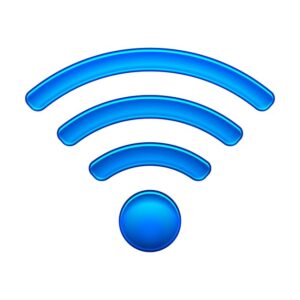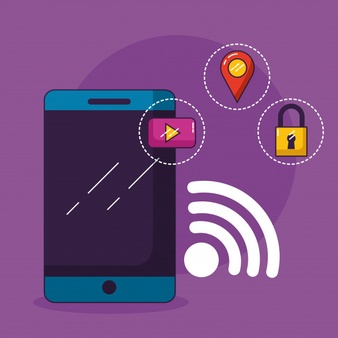Hotspot and Wi-Fi both are common terms always utilized to access the Internet, but there is a difference between Wi-Fi and hotspot.
Wi-Fi is a wireless network technology that uses radiofrequency waves to connect mobile devices to the Internet without cables, while hotspots are typically for public places that use Wi-Fi to connect devices.
Here, we will explain some of the basic differences between them.
What is Wi-Fi?
Wi-Fi is a wireless communication technology that allows mobile devices to use radiofrequency waves to communicate between them without the use of real cables from the Internet.
It is like a wireless local area network that transmits and receives radio waves within devices based on the IEEE 802.11 network standards.
Wi-Fi works with the traditional 2.4 GHz radio frequency band, as it allows devices to be connected within a certain range.
It is the most popular and important means of wireless communication and the best example of Wi-Fi is in the form of a network in your home.
The router receives signals from outside the network, such as your ISP, and transmits them back to your mobile devices, such as laptops or mobiles.

What is Hotspot?
A hotspot is nothing more than a physical location, such as a wireless access point that allows mobile devices to access the Internet using Wi-Fi.
This allows devices to communicate with each other over a wireless local area network, such as using a modem or wireless router to create a portable hotspot connected to the ISP.
The period hotspot is similar to wireless Internet access.
An access point is nothing more than a networking device that provides access to the Internet via Wi-Fi.
Simply users can easily access the Internet wirelessly in public places, such as hotels, cafes, or airports via hotspot.

Difference Between Wi-fi and Hotspot
Wi-Fi vs Hotspot
Wi-Fi and hotspots are used interchangeably to provide Internet access.
There is a big difference between Wi-Fi and hotspot in terms of tempo, effectiveness, safety, and security.
The difference between hotspot and Wi-Fi is very interesting which also matters in both Wi-Fi and hotspot networking.
Wi-Fi is a technology designed for local area networking.
Radiofrequency correlates with electromagnetic waves and the rules governing how communications are defined in a protocol called IEE 802.11.
A hotspot is a place that provides access to the Internet with the use of Wi-Fi.
A hotspot is a device that creates a single access point.
Difference Between Wi-Fi and Hotspot Meaning
Hotspot and Wi-Fi are both common terms used to access wireless internet, meaning they provide wireless internet, but they do it quite differently.
A hotspot is a wireless access point, like a physical location that provides Internet access via a wireless local area network (WLAN), while Wi-Fi is a wireless communication technology that allows you to access the Internet without any wires.
Technology
Wi-Fi: Wi-Fi is a wireless networking protocol that uses radio waves to transmit networks to mobile devices based on the IEEE 802.11 standards.
Like network cables, Wi-Fi is a wireless way to connect devices to a local wireless network.
It is like a wireless local area network that connects devices without cables.
Hotspot: Hotspots are wireless access points that often access the Internet from a physical location using Wi-Fi.
Access
Wi-Fi: Wi-Fi is a non-access network, with the network owner having complete control over who is allowed to use their Wi-Fi network and who is not.
The owner can either change the Wi-Fi network or its password or control the number of people assigned to the network and access the network only for specific people.
It can also turn off the Wi-Fi router to disable network access.
Hotspot: Hotspots are mostly used in airports, hotels, cafes, or on the streets, providing free services to users.
Range
Wi-Fi: Wi-Fi routers operate with a traditional 2.4 GHz radio frequency band to connect devices that are usually within a range.
Transmission is very limited in antenna, environment, or location.
You can also use a Wi-Fi analyzer for this purpose.
The typical indoor Wi-Fi setup has access up to 32 meters, while the outdoor point-to-point system can extend the bandwidth to a few kilometers within stations.
Wi-Fi signals can also be accessed remotely with the help of Wi-Fi Range Extender, another device that has an IP address.

Hotspot: The hotspot can access its signals up to 33 feet away.
Security
Wi-Fi: Wireless networks, especially public Wi-Fi networks, have a higher risk of being hacked because you don’t just connect to the network.
In general, such breaches are less likely to undermine the security of those connected to the network.
Which is perfectly secure with WPA2 encryption. Public Wi-Fi is easy, but the risks are high.
Hotspot: Hotspots are physical locations and almost everyone has access to the Internet, making it one of the best places for possible cyber attacks.
When you use a hotspot, you can use a VPN to stay safe.

Control
Wi-Fi: Wi-Fi gives the user a lot of control.
The user can also set a password and has the option not to share the password, which can limit the number of users in the network.
It can also easily change the password and the number of existing users of the network can also be controlled.
Also, you can risk unwanted people re-using your network, changing settings easily configuring guest Wi-Fi networks.
Hotspot: Internet services with hotspots are mostly provided by large businesses that control public business.
Accordingly, no issue how different people take the Internet service on the hotspot, the settings can just be controlled by the administrator.
Coverage Area
Wi-Fi: In terms of coverage area, hotspot signals have the upper hand.
Different Wi-Fi devices are in a limited range because the network is using a frequency band of 2.4 GHz.
The normal range, which is guaranteed for most Wi-Fi setups, is 32 meters.
Most modern Wi-Fi setups that use the 5 GHz frequency band can reach greater distances than that.
You will also need to use a Wi-Fi repeater or extender if you want to add signals to a larger area.
Hotspot: Hotspot internet services cover distances up to 33 feet.
Safety
Wi-Fi: Lastly, Wi-Fi setups are usually more secure than hotspots. If you are using an encrypted network, then a cyber-attack may not be a problem for you.
Hotspot: But, if you use a hotspot internet service, anyone can detect the password. Your personal information can also be easily stolen and leaked online. Therefore, you must use a VPN service to use a public hotspot.
Key Differences
- Wi-Fi is primarily a time lag used for wireless access to the Internet.
- While a hotspot is a separate type of router or physical system for accessing the Internet through the Wi-Fi experience.
- Wi-Fi itself is a type of Internet service provider.
- Hotspots, on the other hand, are nothing more than an entry point.
- Wi-Fi is much more secure than hotspots because anyone can access the Internet in hotspots and in some cases you can even view visitors to the shopper’s website.
- It can also provide Wi-Fi signals at 20-meter or 66-finger fluctuations, while hotspot signals also enter 33-foot fluctuations.
- Wi-Fi is usually a paid internet service in most places.
- While Hotspot offers a wide range of freebies because it is meant to please shoppers or visitors.
- Hotspot suppliers provide access through a large number of cell or phone corporations. While Wi-Fi suppliers access neighboring areas through Internet service providers.
Wi-Fi vs Hotspot Features Comparison
Wi-Fi
It is an Internet technology that transmits data between mobile devices via radio frequency signals.
That’s why it can transfer information across devices without wires.
It’s very similar to LAN and receives and transmits information based on the 802.11 network protocol.
With impressive features such as long-distance and reliability, the majority of Internet users prefer it for their homes and offices.
The service provider provides a network signal to your router or modem.
The router then gives the signal access to multiple devices in your home.
Typically, this technology uses the 2.4 GHz range to transmit signals.
But, if it interferes with other networks, it also works on the 5 GHz frequency band.
Hotspot
A hotspot is an infrastructure that provides access to Internet signals.
At this particular location, people with the key can connect their mobile devices to the Internet and also access various websites.
Internet service providers transmit Internet signals to a modem or router installed in a public place.
It acts as a LAN to connect various devices from the modem or router to the Internet.
It is also used in malls, restaurants, markets, and additional hospitals.
Its main purpose is to help people who come to these places stay connected.
Future of Wi-Fi and Hotspot
Future of Wi-Fi
Wireless technology is changing rapidly. The way the Internet is used today has changed the lives and businesses of people all over the world.
But what do you think is the future of Wi-Fi?
For some time now, we’ve been noting that Wi-Fi is used in large computers, powerful laptops, tablets, and almost all smartphones.
This allows us to take advantage of Wi-Fi networks to easily streamline our work, study, and play with other devices.
Over the next two years, we will have to look for the growth of the ‘Internet of Things’ the network of any product that you have or think about in wireless communication.
Future of hotspot
So, if the need for 5G Wi-Fi is not getting rid of, and 5G data plans will come down to a great extent then the Wi-Fi hotspot offers a great opportunity for business users and individuals to move on.
With benefits Hotspot 2.0, also known as Wi-Fi Certified Passport, is designed to automatically detect the hotspot from a Wi-Fi connection and the security certification that we need to use Connect without needing to.
In the next few days, you’ll see public places change to Hotspot 2.0.
This will be the standard for wireless hotspots, which may also limit the need for third-party software, which is often encountered by today’s hotspot or hospitality viewers.
In the future, it will have access to the Internet everywhere in the form of wireless communication.

Advantages of Wifi
Convenience
Its users can connect to the wireless network through the same network.
In a fraction of a second, without any configuration, contacts can be made via router or hotspot technology.
It is not used in wired networks.
In a wired network, it can take a long time to create and allow multiple users.
Movements
As long as Wi-Fi access is within the point-up range, you can easily do your work from anywhere with Wi-Fi, even with mobile devices.
You don’t always have to be connected to a computer to access the Internet.
Such tasks include bank transactions, checking, and sending emails.
Productivity
Regardless, a company’s staff can accomplish their assigned tasks with a Wi-Fi network.
Users who use Wi-Fi networks are often adept at experiencing location speeds whenever they move from one location to another.
And with wireless LAN, you’ll be less likely to encounter technical issues.
The result can be more staff engagement and timely delivery of your goals and work, which can greatly increase the company’s overall productivity.
FAQs
Is a phone hotspot the same as WiFi?
Wi-Fi is a wireless network technology that uses radiofrequency waves to connect mobile devices to the Internet without any real cables, while a hotspot is usually a physical location for such public places.
Who use Wi-Fi to connect devices.
Is a hotspot WiFi?
A hotspot is a physical location where people can access the Internet, usually with the use of Wi-Fi, via the Wireless Local Area Network (WLAN), which allows the router to access the Internet service.
Yes, and many public hotspots offer free wireless access to open networks.
Is mobile hotspot faster than WiFi?
Your 4G or LTE data from your phone is often better than your home Wi-Fi.
You might expect that there will be other similar solutions, especially if your Wi-Fi router is connected to the nearest 4G tower, relying on a fixed-line broadband connection.
Does a mobile hotspot need WiFi?
A phone hotspot works with any Wi-Fi-based device, including laptops, tablets, other phones, and even game consoles.
Just look at it as another Wi-Fi source, it’s just from your phone.
Ending Lines
You must know the difference between Wi-Fi and hotspot if you are an internet user.
That’s why we have explained some basic differences between hotspot and Wi-Fi.
Hope after reading this article you will be able to understand this difference.
